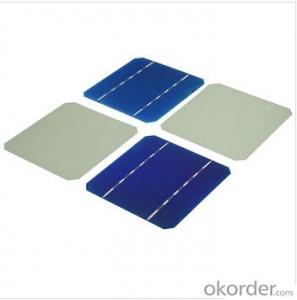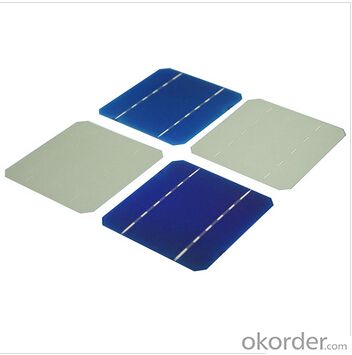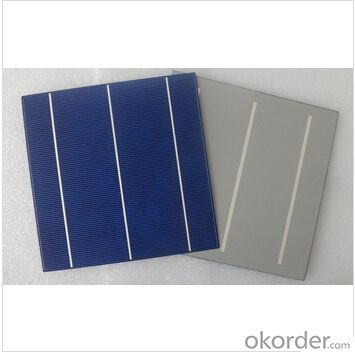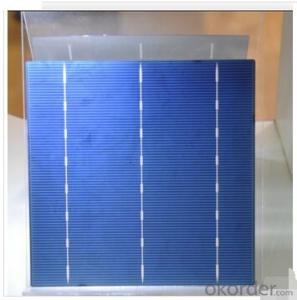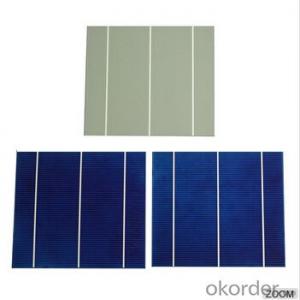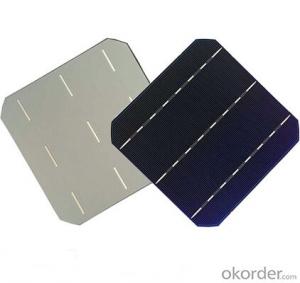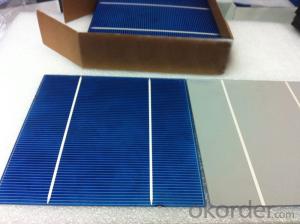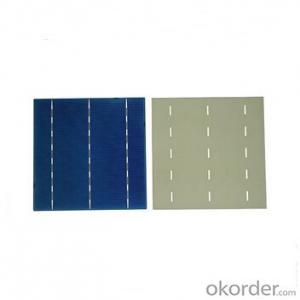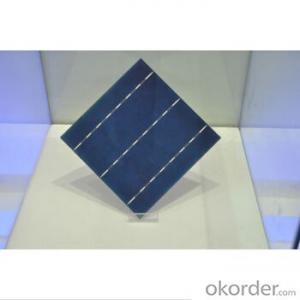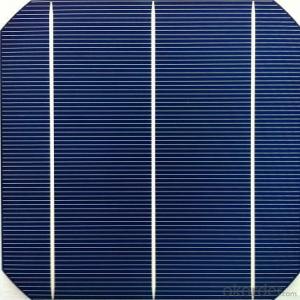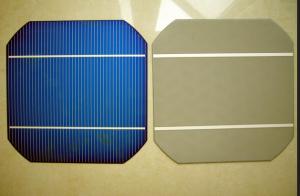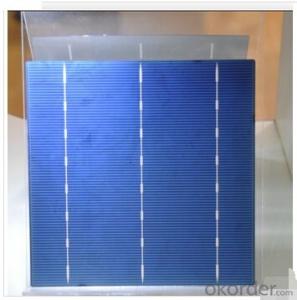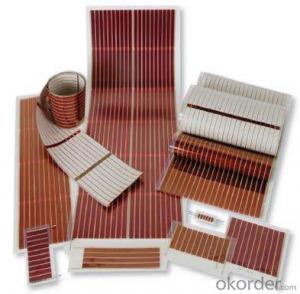Dye Based Polycrystalline Solar Cell High Quality 18.60%-18.80% Effy
- Loading Port:
- Shanghai
- Payment Terms:
- TT OR LC
- Min Order Qty:
- 1000 pc
- Supply Capability:
- 1000000 pc/month
OKorder Service Pledge
OKorder Financial Service
You Might Also Like
Solar Cells:
solar cells, when struck by photons of light from the sun, generates an electrical current which can then be used to power DC or AC electrical loads.
A solar cell is made of silicon. Computer chips are made of this same material. Basically, when light strikes the surface of a solar cell some of it is absorbed into the silicon. This light energy bumps the electrons loose and causes energy to flow
Solar cells is made by solar wafer, it has three categories of solar cell right now, monocrystalline polycrystalline and thin film,These cells are entirely based around the concept of PN junction, which is the critical part of solar module, it is the part that can convert the light energy into electricity, the thickness is from 180um to 200um, with even busbars to conduct electricity, textured cell can decrease diffuse reflection; they are often electrically connected and encapsulated as a module. Photovoltaic modules often have a sheet of glass on the front (sun up) side, allowing light to pass while protecting semiconductor wafers from abrasion and impact due to wind-driven debris, rain, hail, etc. Solar cells are also usually connected in series in modules, creating an additive voltage. Connecting cells in parallel will yield a higher current;With high quality and stable quality. Our Cells can greatly improve the performance of Solar Modules.
Features:
High efficiencies up to 16.4%
Proven long term mechanical stability of silicone
Make of highly purified poly silicone
Three bus bars for reduced series resistance and improved module and cell efficiency
Blue anti-reflecting coating ensures improved light absorption and increased efficiency
Acid texturization offers a uniform appearance and virtually invisible crystal structure
Excellent low light behavior for improved energy yield
Specifications
Efficiency(%) | Pmpp(W) | Umpp(V) | Impp(A) | Uoc(V) | Isc(A) | FF(%) |
18.60-18.80 | 4.53 | 0.54 | 8.382 | 0.637 | 9.084 | 78.23 |
18.40-18.60 | 4.48 | 0.536 | 8.354 | 0.636 | 9.062 | 77.7 |
18.20-18.40 | 4.43 | 0.533 | 8.31 | 0.635 | 9.033 | 77.22 |
18.00-18.20 | 4.38 | 0.532 | 8.234 | 0.634 | 8.987 | 76.88 |
17.80-18.00 | 4.33 | 0.529 | 8.189 | 0.633 | 8.951 | 76.45 |
17.60-17.80 | 4.29 | 0.527 | 8.128 | 0.632 | 8.922 | 75.96 |
17.40-17.60 | 4.24 | 0.525 | 8.066 | 0.629 | 8.902 | 75.63 |
Solar Cells Advantage:
• High efficiency and stable performance in photovoltaic conversion.
• Advanced diffusion technique ensuring the homogeneity of energy conversion efficiency of the cell.
• Advanced PECVD film forming, providing a dark blue silicon nitride anti-reflection film of homogenous color and attractive appearance.
• High quality metal paste for back surface and electrode, ensuring good conductivity, high pulling strength and ease of soldering.
• High precision patterning using screen printing, ensuring accurate busbar location for ease with automatic soldering a laser cutting.
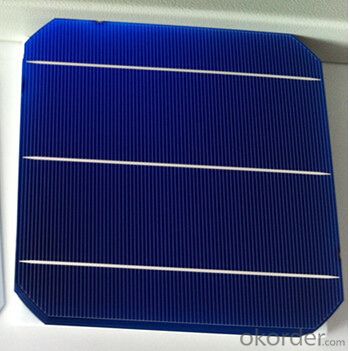
FAQ
We have organized several common questions for our clients,may help you sincerely:
①What price for each watt?
It depends on the efficiency of the solar cell, quantity, delivery date and payment terms.
②How long can we receive the product after purchase?
In the purchase of product within three working days, We will arrange the factory delivery as soon as possible. The pecific time of receiving is related to the state and position of customers.Commonly 7 to 10 working days can be served.
③Can you provide the peripheral products of the solar panels, such as the battery, controller, and inverter? If so, can you tell me how do they match each other?
Yes, we can, we have two companies for solar region, one is CNBM International, the other is CNBM engineering Co.
We can provide you not only the solar module but also the off grid solar system, we can also provide you service with on grid plant.
④What is your warranty of solar cell?
Our product can promise lower than 0.3% open box crack, we support claim after opening the box if it has crackm color difference or sth, the buyer should give pictures immediately, we can not accept the claim after the solar cell has assembled to solar panel.
• Timeliness of delivery
• ⑤How do you pack your products?
We have rich experience on how to pack the solar cell to make sure the safety on shipment, we could use wooden box or pallet as buyer's preference.
- Q: What is the impact of solar cells on reducing energy waste?
- Solar cells have a significant impact on reducing energy waste as they harness the sun's energy to generate electricity without emitting greenhouse gases or consuming any fossil fuels. By converting sunlight into usable electricity, solar cells enable a greener and more sustainable energy source, ultimately minimizing the need for traditional, non-renewable energy sources and reducing overall energy waste.
- Q: Are solar cells affected by pollution?
- Yes, solar cells can be affected by pollution. Air pollution, such as smog and particulate matter, can reduce the efficiency of solar cells by blocking sunlight and reducing the amount of light that reaches the cells. Additionally, pollutants can settle on the surface of solar panels, creating a layer that reduces their ability to generate electricity.
- Q: Can solar cells be used in military vehicles?
- Yes, solar cells can be used in military vehicles. They provide a renewable and sustainable source of energy, reducing dependency on fossil fuels and increasing operational efficiency. Additionally, solar cells can help power various systems and equipment in military vehicles, enhancing their capabilities and reducing logistical challenges in remote or hostile environments.
- Q: Can solar cells be used to power parking meters?
- Yes, solar cells can be used to power parking meters. Solar cells convert sunlight into electricity, making them a sustainable and environmentally friendly power source for various applications, including parking meters. By harnessing solar energy, parking meters can operate independently, reducing the need for frequent battery replacements or connection to the electrical grid.
- Q: Can solar cells be used in smart home automation systems?
- Yes, solar cells can be used in smart home automation systems. Solar cells can provide renewable and clean energy to power various devices and systems in a smart home, including lighting, heating, cooling, and even smart appliances. By integrating solar cells into the automation system, homeowners can reduce their reliance on traditional energy sources, lower their electricity bills, and contribute to a more sustainable and environmentally friendly home.
- Q: Can solar cells be used in remote areas with no access to electricity?
- Yes, solar cells can be used in remote areas with no access to electricity. Solar cells convert sunlight into electricity, making them an ideal solution for areas with no grid connection. They can provide a reliable source of power for various applications, including lighting, charging electronic devices, and running small appliances, thereby improving the lives of people in remote areas.
- Q: What is the role of monitoring systems in solar cell systems?
- The role of monitoring systems in solar cell systems is to continuously monitor and analyze the performance and efficiency of the solar panels. It allows for real-time tracking of the energy production, detecting any malfunctions or abnormalities, and identifying potential issues that may affect the overall system performance. This data helps in optimizing the efficiency of the solar cell system, ensuring maximum energy generation, and enabling timely maintenance and repairs. Monitoring systems also provide valuable insights for system optimization, energy consumption analysis, and performance evaluation.
- Q: How do solar cells perform in cloudy weather?
- Solar cells can still generate electricity in cloudy weather, although their efficiency is reduced compared to sunny conditions. Cloud cover limits the amount of sunlight reaching the solar panels, resulting in a lower energy output. However, modern solar cell technologies are designed to capture diffused sunlight and can still produce a significant amount of electricity even in cloudy weather.
- Q: Can solar cells be used in indoor applications?
- Yes, solar cells can be used in indoor applications. While they are typically designed for outdoor use to harness sunlight, indoor solar cells can still generate electricity from artificial light sources such as fluorescent or LED lights. However, the efficiency of indoor solar cells is generally lower compared to outdoor usage due to the lower intensity and variability of indoor lighting.
- Q: Can solar cells be used in powering remote weather stations?
- Yes, solar cells can be used to power remote weather stations. Solar cells convert sunlight into electricity, making them an ideal and sustainable power source for remote locations where access to traditional power grids may be challenging. The abundance of sunlight in many regions allows solar cells to efficiently generate electricity, providing a reliable source of power for remote weather stations.
Send your message to us
Dye Based Polycrystalline Solar Cell High Quality 18.60%-18.80% Effy
- Loading Port:
- Shanghai
- Payment Terms:
- TT OR LC
- Min Order Qty:
- 1000 pc
- Supply Capability:
- 1000000 pc/month
OKorder Service Pledge
OKorder Financial Service
Similar products
Hot products
Hot Searches
Related keywords
